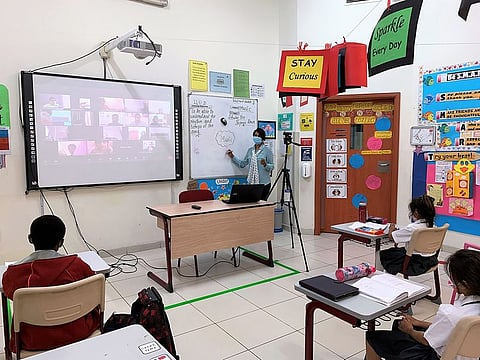COVID-19: Teachers in UAE try to balance in-class and at-home students
Teachers face challenges balancing needs of classroom pupils and distance learners

Dubai: Teachers are finding it challenging to engage both students in the classroom and distance learners at the same time while live streaming lessons from school — a unique arrangement forced by the COVID-19 pandemic.
As UAE schools reopened in August after months of closure under the pandemic, some students returned to the classroom while others are continuing distance learning. However, both groups are being taught at the same time in many cases, through classroom lessons that are shown live to students at home over internet video. “If you had told me a year ago that our teachers would be live streaming and teaching to two adjacent classrooms with students working from home, I would not have believed you. What we have achieved and continue to achieve truly astounds me, and our teachers are at the forefront of this, ensuring that all students continue to engage in meaningful learning experiences,” said Phil Waterworth, Primary Assistant Principal, GEMS Wellington Academy — Al Khail, Dubai.

Learning curve for teachers
Soumya Kappaliyil, a grade two English teacher at Credence High School, Dubai, also said giving the same attention to both groups is a challenge sometimes. “I have to engage all students in learning at the same time, whether they are at home or in classroom. I think it’s a huge learning curve for all teachers,” she added. Kappaliyil has 16 classes per week, with an average of 25 per cent of her students attending face-to-face classes while the rest continue remote learning.
Tech issues can be limiting

GEMS World Academy can accommodate students in some grades with 50 per cent on-campus learning and 50 per cent distance learning rotation based on their house groups. Depending on the day and grade level, around 80 per cent of the school’s students are on campus, while 20 per cent are learning online.
Hybrid makes bonding hard

Janisa has 20 classes per week, with three students in the classroom and 21 students in distance learning.
One-to-one feedback
Though adapting quickly to hybrid teaching has been difficult, it has also “helped us all become better teachers”, said Nicola Steele, head of English and senior teacher, GEMS Wellington Academy — Al Khail. “I try to find as many opportunities for the full class to work together and share ideas by using technology so that it doesn’t feel like there are two different groups of pupils. By having the pupils at home interacting regularly with the pupils in school, it helps to remind everyone that we are all one community, even when we are separated by distance,” she added.
“The biggest challenge is making sure the pupils at home get the same levels of support and time with me as the pupils in school. I make sure to plan for portions of each lesson in which I check in with the pupils at home and give them one-to-one support and feedback.”
Sign up for the Daily Briefing
Get the latest news and updates straight to your inbox






